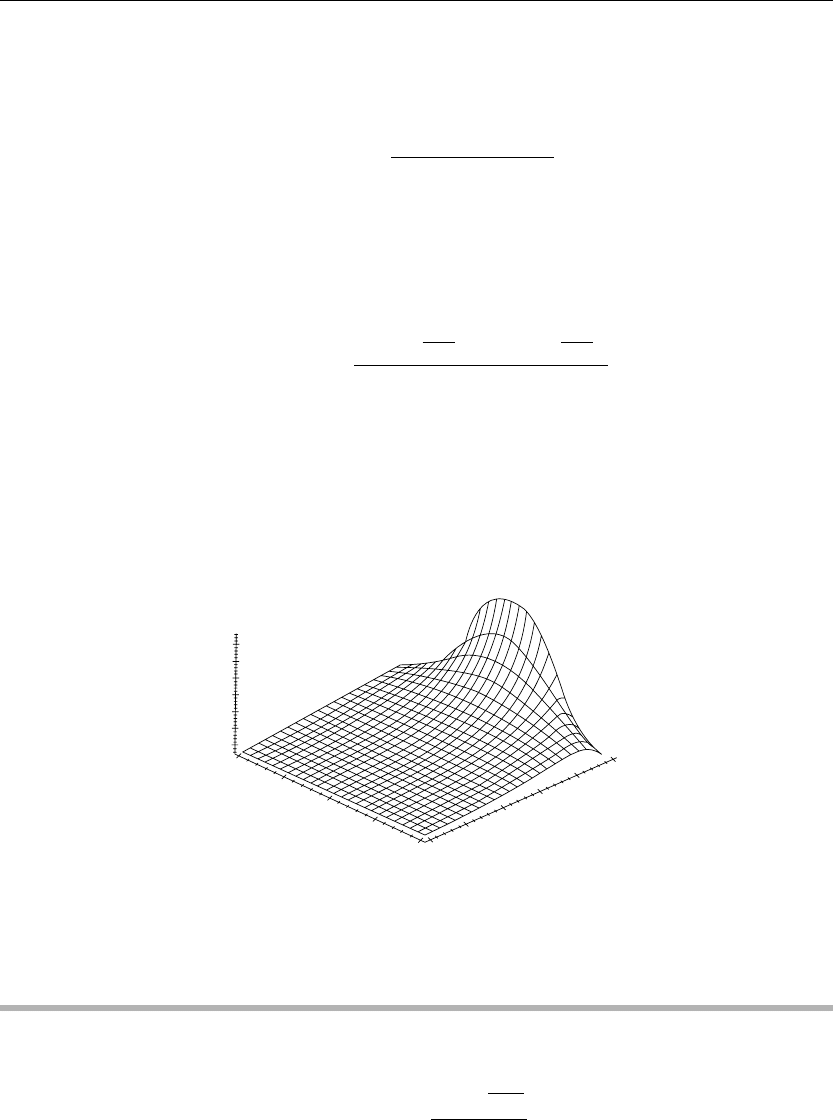Articolo G.A. Partial Differential Equations and Boundary Value Problems with Maple V
Подождите немного. Документ загружается.


618 Chapter 9
Thus, the coefficient C(ω) is found from the following Fourier transform:
> C(omega):=Int(f(y)*exp(−I*omega*y),y=−infinity..infinity);
C(ω) :=
∞
−∞
f(y) e
−Iωy
dy (9.92)
To solve by convolution, we can combine the two preceding integrals, as we did in Section 9.5
for the diffusion equation. Doing so, we get
> u(x,y):=Int(Int(f(zeta)/(2*Pi)*exp(−I*omega*zeta),zeta=−infinity..infinity)*
exp(−abs(omega)*x)*exp(I*omega*y),omega=−infinity..infinity);
u(x, y) :=
∞
−∞
⎛
⎝
∞
−∞
1
2
f(ζ) e
−Iωζ
π
dζ
⎞
⎠
e
−|ω|x
e
Iωy
dω (9.93)
Assuming the validity of the formal interchange of the order of integration yields
> u(x,y):=Int(f(zeta)*Int(exp(−abs(omega)*x)*(1/(2*Pi))*exp(I*omega*(y−zeta)),omega=
−infinity..infinity),zeta=−infinity..infinity);
u(x, y) :=
∞
−∞
f(ζ)
⎛
⎝
∞
−∞
1
2
e
−|ω|x
e
Iω(y−ζ)
π
dω
⎞
⎠
dζ (9.94)
If we set v = y −ζ, then we recognize the interior integral as the Fourier integral of
> assume(x>0):g(x,y−zeta):=subs(v=y−zeta,invfourier(exp(−abs(omega)*x),omega,v));
g(x∼,y−ζ) :=
x∼
x∼
2
+(y −ζ)
2
π
(9.95)
Thus, our solution can be written as the convolution
> u(x,y):=Int(f(zeta)*
g(x,y−zeta)
,zeta=−infinity..infinity);
u(x∼,y):=
∞
−∞
f(ζ)g
(
x, y −ζ
)
dζ (9.96)
We now consider the special case u(0,y)= f(y) where f(y) is given as
> f(y):=Heaviside(y+1)−Heaviside(y−1);f(zeta):=subs(y=zeta,f(y)):
f(y) := Heaviside(y +1) −Heaviside(y −1) (9.97)

Infinite and Semi-infinite Spatial Domains 619
Substitution of this into the previous integral yields the equivalent integral
> u(x,y):=Int(1*x/(Pi*(xˆ2+(y−zeta)ˆ2)),zeta=−1..1);
u(x∼,y):=
1
−1
x∼
x∼
2
+(y −ζ)
2
π
dζ (9.98)
This integrates to
> u(x,y):=value(%);
u(x∼,y):= −
arctan
y+1
x∼
−arctan
y−1
x∼
π
(9.99)
> plot3d(u(x,y),x=0..10,y=−2..2,axes=framed,thickness=1);
The three-dimensional surface shown in Figure 9.10 illustrates the electrostatic potential
distribution u(x, y) over the given region. The electrostatic equipotential lines are obtained by
clicking on the graph and choosing the “Render the plot using the polygon patch and contour
style” option and then clicking the “redraw” button in the graphics bar.
0
2
4
6
8
10
2
1
0
x~
y
22
0.7
0.6
0.5
0.4
0.3
0.2
0.1
21
Figure 9.10
Chapter Summary
Fourier series representation of a function f(x) over a finite domain [−L,L]
f(x) =
∞
n=−∞
F(n) e
inπx
L
2L

620 Chapter 9
Regular orthonormalized eigenfunctions for Euler operator over a finite domain
φ
n
(x) =
√
2e
inπx
L
2
√
L
for n =−3, −2, −1, 0, 1, 2, 3 ....
Statement of orthonormality for the regular eigenfunctions using the Kronecker delta function
L
−L
e
inπx
L
e
−
imπx
L
2L
dx = δ(n, m)
Regular Fourier coefficients
F(n) =
L
−L
f(x) e
−
inπ
L
dx
Fourier integral representation of f(x) over an infinite domain (−∞, ∞)
f(x) =
∞
−∞
F(ω) e
iωx
2π
dω
Singular orthonormalized eigenfunctions for the Euler operator over an infinite domain
√
2e
iωx
2
√
π
for −∞ <ω<∞.
Statement of orthonormality for singular eigenfunctions using the Dirac delta function
∞
−∞
e
iβx
e
−iωx
2π
dx = δ(β −ω)
Singular Fourier coefficients (the Fourier integral)
F(ω) =
∞
−∞
f(x) e
−iωx
dx
The preceding material demonstrated the parallel for the representation of functions over finite
and infinite domains. For the case of finite domains, we used the Fourier series representation

Infinite and Semi-infinite Spatial Domains 621
in terms of the regular orthonormalized eigenfunctions where the regular Fourier coefficients
are evaluated using the statement of orthonormality for regular eigenfunctions. For the case of
infinite domains, we used the Fourier integral representation in terms of the singular
eigenfunctions where the singular Fourier coefficients are evaluated using the equivalent
statement of orthonormality for singular eigenfunctions. Comparison of the Fourier
representation for finite domains and infinite domains and the corresponding statements of
orthonormality for the regular and singular eigenfunctions shown earlier demonstrates
dramatic similarities.
Exercises
We first consider nonhomogeneous diffusion and wave equations in a single dimension over
infinite and semi-infinite intervals in rectangular coordinates. For the situation of infinite
intervals, we use the method of the Fourier integral, which is an extension of the eigenfunction
expansion for finite intervals. For semi-infinite intervals, we use the method of Fourier sine or
cosine integrals or the method of images.
Fourier Integral Solutions of the Diffusion Equation
We consider the temperature distribution along a thin rod whose lateral surface is insulated
over either the infinite interval I ={x |−∞<x<∞} or the semi-infinite interval
I ={x |0 <x<∞}. We allow for an external heat source to act on the system. The
nonhomogeneous diffusion partial differential equation in rectangular coordinates in a single
dimension reads
∂
∂t
u(x, t) = k
∂
2
∂x
2
u(x, t)
+h(x, t) (9.100)
with the initial condition u(x, 0) = f(x). In Exercises 9.1 through 9.23, we seek solutions to the
preceding equation in the form of a Fourier integral with respect to x for various initial and
boundary conditions over infinite or semi-infinite intervals. In some instances, we use the
convolution integral or the method of images to develop the final solution. For the following
exercises, whenever possible, generate the animated solution for u(x, t), and plot the animated
sequence for 0 <t<5.
9.1. Consider a thin cylinder over the infinite interval I ={x |−∞<x<∞} containing a
fluid that has an initial salt concentration density given as f(x). There is no source term
in the system, and the diffusivity is k = 1/4. Evaluate the concentration distribution
density u(x, t) in the form of a Fourier integral. Evaluate the inverse by using either the
inverse command or a convolution integral.

622 Chapter 9
Boundary condition:
∞
−∞
|u(x, t)|dx<∞
Initial condition:
f(x) = e
−
|x|
2
9.2. Consider a thin rod whose lateral surface is insulated over the infinite interval
I ={x |−∞<x<∞}. The initial temperature distribution in the rod is given as f(x).
There is no source term in the system, and the diffusivity is k = 1/4. Evaluate the
temperature distribution u(x, t) in the form of a Fourier integral. Evaluate the inverse by
using either the inverse command or a convolution integral.
Boundary condition:
∞
−∞
|u(x, t)|dx<∞
Initial condition:
f(x) = x e
−
|x|
2
9.3. Consider a thin cylinder over the infinite interval I ={x |−∞<x<∞} containing a
fluid that has an initial salt concentration density given as f(x). There is no source term
in the system, and the diffusivity is k = 1/4. Evaluate the concentration distribution
density u(x, t) in the form of a Fourier integral. Evaluate the inverse by using either the
inverse command or a convolution integral.
Boundary condition:
∞
−∞
|u(x, t)|dx<∞
Initial condition:
f(x) =
1
1 +x
2
9.4. Consider a thin rod whose lateral surface is insulated over the infinite interval
I ={x |−∞<x<∞}. The initial temperature distribution in the rod is given as f(x).
There is no source term in the system, and the diffusivity is k = 1/4. Evaluate the
temperature distribution density u(x, t) in the form of a Fourier integral. Evaluate the
inverse by using either the inverse command or a convolution integral.

Infinite and Semi-infinite Spatial Domains 623
Boundary condition:
∞
−∞
|u(x, t)|dx<∞
Initial condition:
f(x) = e
−
x
2
2
9.5. Consider a thin cylinder over the infinite interval I ={x |−∞<x<∞} containing a
fluid that has an initial salt concentration density given as f(x). There is no source term
in the system, and the diffusivity is k = 1/4. Evaluate the concentration distribution
density u(x, t) in the form of a Fourier integral. Evaluate the inverse by using either the
inverse command or a convolution integral.
Boundary condition:
∞
−∞
|u(x, t)|dx<∞
Initial condition:
f(x) = x e
−
x
2
2
9.6. Consider a thin rod whose lateral surface is insulated over the infinite interval
I ={x |−∞<x<∞}. The initial temperature distribution in the rod is given as f(x).
There is no source term in the system, and the diffusivity is k = 1/4. Evaluate the
temperature distribution u(x, t) in the form of a Fourier integral. Evaluate the inverse by
using either the inverse command or a convolution integral.
Boundary condition:
∞
−∞
|u(x, t)|dx<∞
Initial condition:
f(x) =
x
(1 +x
2
)
2
9.7. Consider a thin cylinder over the semi-infinite interval I ={x |0 <x<∞} containing a
fluid that has an initial salt concentration density given as f(x). There is no source term
in the system, and the diffusivity is k = 1/4. Evaluate the concentration distribution
density u(x, t) in the form of a Fourier sine integral. Evaluate the inverse by using either
the inverse command or a convolution integral.

624 Chapter 9
Boundary conditions:
u(0,t)= 0 and
∞
0
|u(x, t)|dx<∞
Initial condition:
f(x) = x e
−
x
2
9.8. Consider Exercise 9.7. Develop the odd extension of f(x) and solve the problem by the
method of images.
9.9. Consider a thin rod whose lateral surface is insulated over the semi-infinite interval
I ={x |0 <x<∞}. The initial temperature distribution in the rod is given as f(x).
There is no source term in the system, and the diffusivity is k = 1/4. Evaluate the
temperature distribution u(x, t) in the form of a Fourier sine integral. Evaluate the
inverse by using either the inverse command or a convolution integral.
Boundary conditions:
u(0,t)= 0 and
∞
0
|u(x, t)|dx<∞
Initial condition:
f(x) =
x
1 +x
2
9.10. Consider Exercise 9.9. Develop the odd extension of f(x) and solve the problem by the
method of images.
9.11. Consider a thin cylinder over the semi-infinite interval I ={x |0 <x<∞} containing a
fluid that has an initial salt concentration density given as f(x). There is no source term
in the system, and the diffusivity is k = 1/4. Evaluate the concentration distribution
density u(x, t) in the form of a Fourier sine integral. Evaluate the inverse by using either
the inverse command or a convolution integral.
Boundary conditions:
u(0,t)= 0 and
∞
0
|u(x, t)|dx<∞
Initial condition:
f(x) = x e
−
x
2
4

Infinite and Semi-infinite Spatial Domains 625
9.12. Consider Exercise 9.11. Develop the odd extension of f(x) and solve the problem by
the method of images.
9.13. Consider a thin rod whose lateral surface is insulated over the semi-infinite interval
I ={x |0 <x<∞}. The initial temperature distribution in the rod is given as f(x).
There is no source term in the system, and the diffusivity is k = 1/4. Evaluate the
temperature distribution u(x, t) in the form of a Fourier cosine integral. Evaluate the
inverse by using either the inverse command or a convolution integral.
Boundary conditions:
u
x
(0,t)= 0 and
∞
0
|u(x, t)|dx<∞
Initial condition:
f(x) = e
−
x
2
9.14. Consider Exercise 9.13. Develop the even extension of f(x) and solve the problem by
the method of images.
9.15. Consider a thin cylinder over the semi-infinite interval I ={x |0 <x<∞} containing a
fluid that has an initial salt concentration density given as f(x). There is no source term
in the system, and the diffusivity is k = 1/4. Evaluate the concentration distribution
density u(x, t) in the form of a Fourier cosine integral. Evaluate the inverse by using
either the inverse command or a convolution integral.
Boundary conditions:
u
x
(0,t)= 0 and
∞
0
|u(x, t)|dx<∞
Initial condition:
f(x) =
1
1 +x
2
9.16. Consider Exercise 9.15. Develop the even extension of f(x) and solve the problem by
the method of images.
9.17. Consider a thin rod whose lateral surface is insulated over the semi-infinite interval
I ={x |0 <x<∞}. The initial temperature distribution in the rod is given as f(x).
There is no source term in the system, and the diffusivity is k = 1/4. Evaluate the
temperature distribution u(x, t) in the form of a Fourier cosine integral. Evaluate the
inverse by using either the inverse command or a convolution integral.

626 Chapter 9
Boundary conditions:
u
x
(0,t)= 0 and
∞
0
|u(x, t)|dx<∞
Initial condition:
f(x) = e
−
x
2
4
9.18. Consider Exercise 9.17. Develop the even extension of f(x) and solve the problem by
the method of images.
9.19. Consider a thin rod whose lateral surface is insulated over the infinite interval
I ={x |−∞<x<∞}. The initial temperature distribution in the rod is given as f(x).
There is a heat source term h(x, t) (dimension of degrees per second) in the system, and
the diffusivity is k = 1/4. Evaluate the temperature distribution u(x, t) in the form of a
Fourier integral. If possible, evaluate the inverse by using either the inverse command
or a convolution integral.
Boundary condition:
∞
−∞
|u(x, t)|dx<∞
Initial condition:
f(x) = 0
Heat source:
h(x, t) = e
−
|x|
2
cos(t)
9.20. Consider a thin rod whose lateral surface is insulated over the infinite interval
I ={x |−∞<x<∞}. The initial temperature distribution in the rod is given as f(x).
There is a heat source term h(x, t) (dimension of degrees per second) in the system, and
the diffusivity is k = 1/4. Evaluate the temperature distribution u(x, t) in the form of a
Fourier integral. If possible, evaluate the inverse by using either the inverse command
or a convolution integral.
Boundary condition:
∞
−∞
|u(x, t)|dx<∞

Infinite and Semi-infinite Spatial Domains 627
Initial condition:
f(x) = 0
Heat source:
h(x, t) = x e
−
|x|
2
sin(t)
9.21. Consider a thin rod whose lateral surface is insulated over the infinite interval
I ={x |−∞<x<∞}. The initial temperature distribution in the rod is given as f(x).
There is a heat source term h(x, t) (dimension of degrees per second) in the system, and
the diffusivity is k = 1/4. Evaluate the temperature distribution u(x, t) in the form of a
Fourier integral. If possible, evaluate the inverse by using either the inverse command
or a convolution integral.
Boundary condition:
∞
−∞
|u(x, t)|dx<∞
Initial condition:
f(x) = 0
Heat source:
h(x, t) =
cos(t)
1 +x
2
9.22. Consider a thin rod whose lateral surface is insulated over the infinite interval
I ={x |−∞<x<∞}. The initial temperature distribution in the rod is given as f(x).
There is a heat source term h(x, t) (dimension of degrees per second) in the system, and
the diffusivity is k = 1/4. Evaluate the temperature distribution u(x, t) in the form of a
Fourier integral. If possible, evaluate the inverse by using either the inverse command
or a convolution integral.
Boundary condition:
∞
−∞
|u(x, t)|dx<∞
Initial condition:
f(x) = 0
